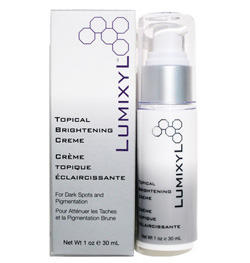In the past few months, as my natural summer tan gradually faded, I began to notice a cluster of dark spots around my hairline. Though they were only visible in certain lighting when my hair was completely pulled back, my face was not ready to roll out the welcome mat. Having exhausted my supplies of Caudalie Vinoperfect Radiance Serum and PrescribedSolutions Brightening Boosters, I sought out something new. I was drawn to Lumixyl Topical Brightening Creme ($120 in the shop) because of its non-toxic profile and multipurpose technology, developed by dermatological researchers at Stanford University. Lumixyl relies on a synthetic peptide, comprising a sequence of amino acids, as its primary defense against hyperpigmentation, but it also incorporates time-honored ingredients believed to aid in treating discoloration.
The consistency of Lumixyl is too thin to work as a spot treatment. Unless fully rubbed in, the scent-free solution will sit on top of the skin, which may not be a problem if used at nighttime. I found Lumixyl to perform best as a base layer under my cream, making sure to rub it in along my hairline. The formula boasts a number of decent emollients and humectants, including caprylic/capric triglycerides, glycerin, sodium PCA, pentylene glycol, and cetearyl alcohol. Better yet, sodium hyaluronate can penetrate deep into the dermis and fill the spaces between the skin's connective fibers with moisture. In addition, there is bis-ethoxydiglycol cyclohexane 1,4-dicarboxylate, a somewhat new synthetic ingredient that acts as a conditioning agent in skincare and haircare products.
But Lumixyl is far from an everyday moisturizer. Natural lightening abilities stem from licorice root extract, also beneficial for atopic dermatitis. Marketed under the name SymWhite 377, Phenylethyl Resorcinol is a synthetic compound partly derived from natural lightening compounds in scotch pine bark. Studies have shown that it is effective at brightening skin without harmful side effects. It is claimed that allantoin can have a keratolytic effect and stimulate the growth of healthy tissue. These properties would certainly help with exfoliating away a layer of dark skin, and there is no doubt that allantoin has anti-inflammatory powers. Phyllanthus emblica fruit extract, or Indian gooseberry, confers anti-inflammatory properties, while panthenol, or the provitamin of B5, adds essential moisture and improves healing in the skin.
What about the star peptide behind Lumixyl's brightening power? Dark spots are the result of an overproduction of melanin, and Lumixyl slows this process before it starts, achieving results without irritation caused by commonly used brightening products. The synthetic peptide used in Lumixyl does not topically bleach the skin like hydroquinone, but rather restrains tyrosinase, the enzyme responsible for the production of melanin. To find out more about peptides that act as tyrosinase inhibitors and the scientific findings that went into Lumixyl's formula, read the U.S. patent application.
Clinical studies conducted at Stanford have reported that in eight weeks, skin treated topically with Lumixyl showed a 40% improvement in melanin-related darkening. In fact, Lumixyl's active proved to be 5.5 times more effective than an equal dosage of hydroquinone. According to the results of volunteers in the trial, Lumixyl not only reduced photo damage and diminished dark spots but also restored luminosity to the skin. Moreover, it accomplished all of this without increasing sensitivity to sunlight or triggering hypopigmentation (loss of skin color). The study also confirmed that Lumixyl is safe for all skin types and does not irritate. I wonder, however, whether the full contents of the formula were put to the test, considering the moderately irritating ingredients at the tail end of the list: aminomethyl propanol, tetrasodium EDTA, chlorphenesin, and phenoxyethanol.
Lumixyl is not going to win any "most natural formula" awards, but the brand never pretends to chase such accolades. Its actives are a big improvement on skin-irritating hydroquinone, which has banned by the FDA for its links to cancer. And the baddies are neither sufficiently nasty nor concentrated to scare me off. After eight full weeks of testing Lumixyl, I am happy to report that the dark aberrations along my hairline are almost completely gone and my general skin tone seems much more even. I can only recommend Lumixyl with the caveat that it is pricey ($120) and takes much more diligence than a cosmetic procedure (i.e. Intense Pulsed Light, laser resurfacing, microdermabrasion). But in comparison, it is a terrific deal. I only hope there is enough solution left in my bottle of Lumixyl to salvage my sun-damaged chest area.
Lumixyl Topical Brightening Creme is now on sale in the TIA shop
Ingredients:
Water, Aloe Barbadensis Leaf Juice, Caprylic/Capric Triglyceride, Pentylene Glycol, Glycerin, Bis-Ethoxydiglycol Cyclohexane 1,4-Dicarboxylate, Cetearyl Alcohol, Dimethicone, Decapeptide-12, Sodium Hyaluronate, Sodium PCA, Phenylethyl Resorcinol, Phyllanthus Emblica Fruit Extract, Panthenol, Allantoin, Glycyrrhiza Glabra (Licorice) Root Extract, Limnanthes Alba (Meadowfoam) Seed Oil, Cetyl Alcohol, Dicetyl Phosphate, Ceteth-10 Phosphate, Sclerotium Gum, Aminomethyl Propanol, Butylene Glycol, Tetrasodium EDTA, Chlorphenesin, Caprylyl Glycol, Phenoxyethanol.
truthinaging.com

No comments:
Post a Comment